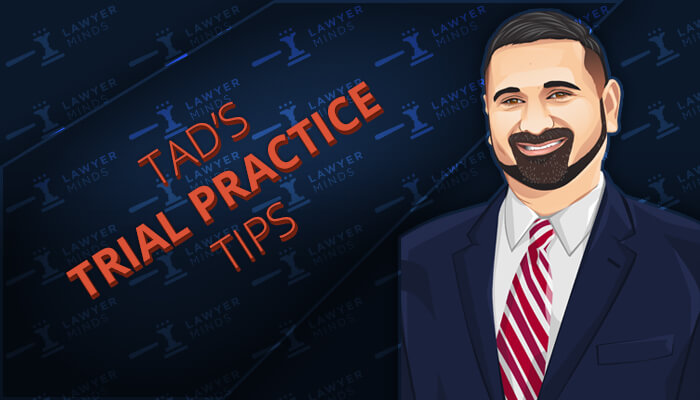Tips for Videoconference Court Appearances

Join me as I talk tips for upping your trial performance. I’ll cover all aspects of the trial, including, jury selection, opening statements, direct witness testimony, cross-examination, closing arguments, jury instructions, and verdicts. Discussions are welcome in the comments section.
— Tad Thomas
The COVID-19 pandemic has significantly altered how we practice law and represent clients. With the need for social distancing, we’ve all probably experienced remote court appearances. Even as vaccinations are distributed, and people return to their previous way of life, it’s likely we’ll continue to see videoconference hearings. Because of that, it’s important to stay abreast of trends and procedures when it comes to preparing for virtual court appearances, knowing about the required technology and equipment, and helping your client participate in the video hearing.
Preparing for a Virtual Court Appearance
Well before the videoconference begins, make sure you select a quiet location where you can remain throughout the course of the session. You’ll want a neutral background to avoid being distracted and make sure any personal items you would not want the court to see are out of the way.
Depending on the conference and your location, you could be using a computer, smartphone, or tablet. Regardless, make sure the device is charged and stationary. It’s also important to be mindful of what you’re wearing. While working from home for the past year, it’s likely a lot of us have gotten used to working in more casual clothes, but it’s important to dress in the same type of clothing you would wear if you were appearing in court in person.
You’ll also want to do a test run before the conference starts. Explain to your client how testing the software works, so they can make sure their equipment is functioning properly if they are not in the same location as you.
Make sure you discuss confidentiality with your client before the session begins. It’s important to avoid sharing confidential information or have confidential discussions during the appearance. If there are muting or chat functions, discuss those with your client as well.
Technology and Equipment
The technology and equipment used during videoconference court appearances need to be secure and easy to use. Encryption is important, and you want to make sure participating parties have quality video and audio capabilities.
Attorneys have a responsibility to preserve their clients’ confidentiality. That responsibility extends to when you are virtually working. Video conference tools should be vetted prior to being used to determine how data is stored.
Depending on the situation, you may not be in control of what software is used for your client’s videoconference hearing. If that’s the case, it’s still important to be aware of what is being used and how you can make special efforts to ensure your client’s information is protected.
Most video call software that deals with sensitive information use a high degree of encryption known as end-to-end encryption. This only allows the users communicating with each other to access the audio, video, and chat.
Participating in a Remote Video Hearing
A few before the hearing begins, log into the required application and make sure your client logins in as well. Depending on the hearing, you may be placed in a waiting room until the person in charge of the conference authorizes it to start. The conference can begin anytime past the start time, so make sure you and your client are ready. Waiting room or not, assume that your video will be viewable to all participants as soon as you log in.
During the virtual hearing, the judge or court officer will inform the participants of how the meeting will run. Your client should defer to you when it comes to speaking. This way, they will be ready to respond in case the judge asks a question.
There is the possibility technological issues could arise. In the event you are able to connect to the hearing but cannot see or hear others on the call, you may be able to use the chat function to communicate to the judge what is happening. Avoid just leaving the chat, as that could jeopardize your client’s case. In addition to that, make sure all tech issues are documented. This way, any potential mixed messages can be easily clarified.
As technology continues to affect how we as trial attorneys practice law, it’s important to learn the ins and outs of videoconferencing. This way, virtual meetings can be productive while clients’ information is kept secure. No matter how much experience you have with videoconference court appearances, there’s always something new to learn. Not only will expanding your knowledge ensure successful virtual court appearances, but you’ll also be working on improving the client experiences and expanding the ways you interact with clients.


